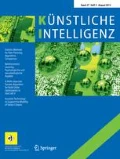Abstract
Large corpora of place descriptions provide abundant human spatial knowledge, different from the geometry-based information stored in current GIS. These place descriptions, used in everyday communication, frequently refer to landmarks. This paper suggests a model for extracting landmarks from web-harvested place descriptions, considering the landmark’s cognitive significance. The model allows landmarks to be extracted according to different contexts via web harvesting and text classification methods. In this work, an implementation of our approach is used to extract context-based landmarks for a target area—Melbourne in Australia.





Similar content being viewed by others
References
Abdelkader A, Hand E, Samet H (2015) Brands in newsstand: spatio-temporal browsing of business news. In: Proceedings of the 23rd SIGSPATIAL international conference on advances in geographic information systems, ACM, New York, NY, USA, GIS ’15, pp 1–4
Adams B, McKenzie G, Gahegan M (2015) Frankenplace: interactive thematic mapping for ad hoc exploratory search. Proceedings of the 24th international conference on World Wide Web. ACM, New York, NY, USA, pp 12–22
Caduff D, Timpf S (2008) On the assessment of landmark salience for human navigation. Cogn Process 9(4):249–267
Couclelis H, Golledge RG, Gale N, Tobler W (1987) Exploring the anchor-point hypothesis of spatial cognition. J Environ Psychol 7(2):99–122
Denis M, Pazzaglia F, Cornoldi C, Bertolo L (1999) Spatial discourse and navigation: an analysis of route directions in the city of Venice. Appl Cogn Psychol 13(2):145–174
Duckham M, Winter S, Robinson M (2010) Including landmarks in routing instructions. J Locat Based Serv 4(1):28–52
Elias B (2003) Extracting landmarks with data mining methods. In: Kuhn W, Worboys M, Timpf S (eds) Spatial information theory, lecture notes in computer science, vol 2825. Springer, Berlin, pp 375–389
Hall M, Frank E, Holmes G, Pfahringer B, Reutemann P, Witten IH (2009) The WEKA data mining software: an update. ACM SIGKDD Explor 11(1):10–18
Khan A, Vasardani M, Winter S (2013) Extracting spatial information from place descriptions. In: Proceedings of the first ACM SIGSPATIAL international workshop on computational models of place, New York, NY, COMP ’13, pp 62–69
Kim J, Vasardani M, Winter S (2015) Harvesting large corpora for generating place graphs. In: Bertel S, Kiefer P, Klippel A, Scheider S, Thrash T (eds) International workshop on cognitive engineering for spatial information processes (CESIP), in conjunction with COSIT 2015
Kim J, Vasardani M, Winter S (2016) Similarity matching for integrating spatial information extracted from place descriptions. Int J Geograph Inf Sci, Taylor & Francis Ltd
Liu F, Vasardani M, Baldwin T (2014) Automatic identification of locative expressions from social media text: a comparative analysis. In: Proceedings of the 4th international workshop on location and the web. ACM, Shanghai, China, pp 9–16
Loh WY (2008) Classification and regression tree methods. In: Ruggeri F, Kenett R, Faltin FW (eds) Encyclopedia of statistics in quality and reliability. Wiley, pp 315–323
Lynch K (1960) The image of the city. MIT Press, Cambridge, MA
Manning CD, Raghavan P, Schütze H et al (2008) Introduction to information retrieval, vol 1. Cambridge University Press, Cambridge
Mário JS, Bruno M, Marcirio C, Ana Paula A, Nuno C (2006) Adding geographic scopes to web resources. Comput Environ Urban Syst 30(4):378–399
Mukherjea S, Foley J (1995) Visualizing the world-wide web with the navigational view builder. Comput Netw ISDN Syst 27(6):1075
Murai Y, Okada M, Hashimoto K (2011) Characteristics of human route descriptions and their improvement by machine landmark extraction. Third international IEEE conference on awareness science and technology. Dalian, China, pp 438–443
Newman MEJ (2010) Networks: an introduction. Oxford University Press, New York
Purves R (2011) Methods, examples and pitfalls in the exploitation of the geospatial web. In: Hesse-Biber S (ed) The handbook of emergent technologies in social research. Oxford University Press, New York, pp 592–622
Quesnot T, Roche S (2014) Measure of landmark semantic salience through geosocial data streams. ISPRS Int J Geo-Inf 4(1):1–31
Raubal M, Winter S (2002) Enriching wayfinding instructions with local landmarks. In: Egenhofer MJ, Mark DM (eds) Geograph Inf Sci. Springer, Berlin, pp 243–259
Sadalla EK, Burroughs WJ, Staplin LJ (1980) Reference points in spatial cognition. J Exp Psychol Hum Learn Mem 6(5):516–528
Sorrows M, Hirtle S (1999) The nature of landmarks for real and electronic spaces. In: Freksa C, Mark D (eds) Spatial Information theory, lecture notes in computer science, vol 1661. Springer, Berlin, pp 37–50
Tezuka T, Tanaka K (2005) Landmark extraction: a web mining approach. In: Cohn A, Mark D (eds) Spatial Information theory, lecture notes in computer science, vol 3693. Springer, Berlin, pp 379–396
Tomko M (2004) Case study-assessing spatial distribution of web resources for navigation services. In: Proceedings of the 4th international workshop on web and wireless geographical information systems, W2GIS04. Goyang, Korea, pp 90–104
Vasardani M, Winter S, Richter K (2013) Locating place names from place descriptions. Int J Geograph Inf Sci 27(12):2509–2532
Winter S, Richter KF (2014) Landmarks: GIScience for intelligent services. Springer, New York
Author information
Authors and Affiliations
Corresponding author
Additional information
Funding by ARC LP100200199 is acknowledged.
Rights and permissions
About this article
Cite this article
Kim, J., Vasardani, M. & Winter, S. Landmark Extraction from Web-Harvested Place Descriptions. Künstl Intell 31, 151–159 (2017). https://doi.org/10.1007/s13218-016-0467-3
Received:
Accepted:
Published:
Issue Date:
DOI: https://doi.org/10.1007/s13218-016-0467-3




